Rice trading in the Mekong Delta has slowed recently as traders reduce purchases due to concerns about exporting to the Philippines. Huyen, a long-time trader in An Giang, said she is only buying sparingly to supply the domestic market, while exports are on hold pending further information from businesses.
In Dong Thap, mills are prioritizing shipments of existing orders to the Philippines, while new purchases have decreased significantly. Prices for Dai Thom 8 and OM18 rice have dropped from 11,500 to 11,000 dong per kg (before color sorting).
In Sa Dec on 15/8, paddy rice prices fell a further 100-200 dong per kg. OM18 rice is generally priced at 9,500-9,600 dong, with higher quality at 9,700 dong; OM5451 is at 8,700-8,800 dong, while OM380 remains at 8,200-8,300 dong. Standard rice prices are stable, while fragrant and glutinous rice prices have slightly decreased.
Speaking with VnExpress, a rice exporter in Dong Thap admitted that their business plans have been disrupted by the Philippines' import suspension. The Philippines is their largest export market. The suspension during the peak harvest season has caused contract delays, increased inventory, and inflated storage costs. The financial burden is mounting, with the risk of significant losses, especially with the 5% VAT implemented from 1/7/2025 and high lending rates.
Nguyen Chi Thanh, director of the rice division at Angimex, predicts that summer-autumn and autumn-winter rice prices could fall sharply. Finding new markets is challenging, and other importing countries may take advantage of the situation to lower purchase prices.
 |
Harvesting rice in the Mekong Delta. Photo: Thuy Tien |
Harvesting rice in the Mekong Delta. Photo: Thuy Tien
Since 2019, businesses have reported delays in obtaining sanitary and phytosanitary import clearance certificates (SPS-IC) for the Philippines, making it difficult to sign long-term contracts. Although online licensing was implemented from 7/7/2025, the paperwork and associated costs have significantly reduced profits.
In a document sent to the Ministry of Industry and Trade a few days ago, Do Ha Nam, chairman of the Vietnam Food Association (VFA), said the Philippines accounts for 40-45% of Vietnam's rice exports. The import suspension is leading to contract delays, increased inventory, reduced liquidity, and downward pressure on domestic rice prices.
The Ministry of Industry and Trade also reported that, in addition to the impact of the Philippines' decision, many rice contracts in August were delayed due to the lack of SPS-IC certificates. This situation increases the risk of inventory buildup, lowers export prices, reduces profits, and directly affects farmers' incomes.
The Ministry warned that large inventories and falling prices will increase credit pressure on businesses. It recommends that companies maintain reserves and wait for the market to reopen to avoid panic selling. It also urges increased coordination between ministries, sectors, and associations to mitigate risks and expand markets to the Middle East, Africa, and Northeast Asia.
The Philippines stated that the two-month import suspension aims to protect domestic production amid falling rice prices. The VFA has requested the Ministry of Industry and Trade to work with the Philippines to clarify the types of rice affected and address SPS-IC procedures to maintain trade, minimize damage, and protect farmers' interests. Vietnam and the Philippines currently have a memorandum of understanding on rice trade cooperation signed on 30/1/2024, valid until 31/12/2028.
The rice industry also seeks support from ministries and sectors for smooth production and export activities. The Ministry of Industry and Trade has proposed that the Prime Minister direct the Ministry of Finance to expedite VAT refunds for rice exporters and proactively plan national rice reserves for 2025 to respond to unfavorable market fluctuations.
According to the Ministry of Agriculture and Rural Development, in the first 7 months of the year, the Philippines was Vietnam's largest rice market, accounting for 42.6% of exports. However, compared to the same period last year, the value of rice exports to the Philippines decreased by 13.5%, while other markets like Ghana increased by 53.5% and Ivory Coast by 96.6%. Among the top 15 export markets, rice export value increased most significantly in Bangladesh, by over 188 times.
Thi Ha












